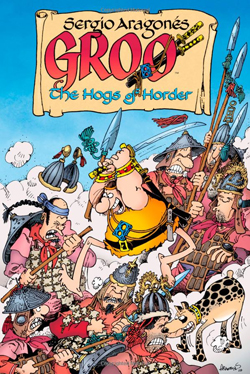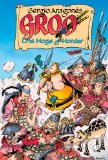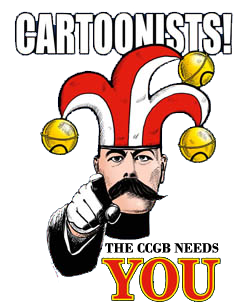 By Sergio Aragones & Mark Evanier
By Sergio Aragones & Mark Evanier
Publisher: Dark Horse
ISBN: 978-1595824233
If you've ever picked up a copy of Mad Magazine then you can't have failed to have noticed the Mad marginals, the tiny cartoon gags filling up the empty spaces between stories, down the margins and across the fold. These are the work of Sergio Aragones, one of my all time favourite cartoonists. For donkey's years he's also been producing an on-again off-again comic called Groo. The concept is loosely based around that of Conan accept that this barbarian is utterly inept, ugly, accident-prone, smelly, stupid and fond of cheese dip. His only two redeeming features are that he is an unstoppable swordsman and his fondness for his dog, Rufferto.
I first came across Groo on the Isle of Wight twenty years ago. In a typical Groo moment, the handlebars of my bike had come off in my hands, and I was monetarily stuck in a small village. While awaiting help I popped into a newsagent looking for something to read and came out with a copy of Groo. I'd go as far to say that he's my favourite cartoon creation of all time, and I've since tracked down every issue ever published.
There are lots of repeating gags in Groo, many of them the result of scribe Mark Evanier, and there are a vast cast of regular and not-so-regular characters. The title has gone through a whole host of publishers and currently resides at Dark Horse and exists as four-issue story arcs printed about once a year. Those issues are then collected into handy trade paperbacks.
Like many of the tales, Hogs of Horder holds a mirror up to modern day problems and reflects them in terms of the world of Groo. This particular story sees Groo travelling from one land, where everyone is poor but works industriously, to a new, wealthier kingdom. After several mishaps he brings the cheaper produce of the former nation to the attention of the latter and greed and a quick profit naturally follow. Before long the wealthier kingdom has no industry, high unemployment, a problem with the banks and the distraction of war. It all sounds very political and serious, and there are grains of truth in it (which is why it's often so funny), but it's just a satirical vehicle for the bumbling incompetence of Groo.
The real joy, for me, is Sergio Aragones's artwork. It is so beautifully effortless and detailed, and it's mind boggling how he can draw so many different and complicated costumes, armour, buildings, ships and landscapes. You so rarely see repetition, and because it's a world of barter and of markets, many scenes are complicated crowds carrying, fetching, selling and buying all sorts of assorted objects. But what really makes it remarkable is that he'll often draw a page while he's waiting somewhere (in an airport, for example), so with no reference material, and little time, he'll knock out a fantastically detailed page which you can identify from the occasional little note written in the bottom corner. He also includes lengthy Rufferto strips, without any words, relying on the power of his visual storytelling to narrate the tale.
All in all, an absolute joy, and if you've not come across Sergio or Groo before then you really should give them a whirl.
And if you liked that: Mad are releasing a huge Sergio Aragones tome shortly – I'll let you know what it's like



No comments yet.